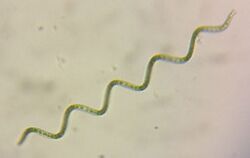Biology:Arthrospira platensis
| Arthrospira platensis | |
|---|---|

| |
| A single Arthrospira platensis colony | |
| Scientific classification Error creating thumbnail: Unable to save thumbnail to destination
| |
| Domain: | Bacteria |
| Phylum: | Cyanobacteria |
| Class: | Cyanophyceae |
| Order: | Oscillatoriales |
| Family: | Microcoleaceae |
| Genus: | Arthrospira |
| Species: | A. platensis
|
| Binomial name | |
| Arthrospira platensis Gomont
| |
Arthrospira platensis is a filamentous, gram-negative cyanobacterium. This bacterium is non-nitrogen-fixing photoautotroph.[1] It has been isolated in Chenghai Lake, China, soda lakes of East Africa, and subtropical, alkaline lakes.[2][3][4]
Morphology
Arthrospira platensis is filamentous, motile bacterium. Motility has been described as a vigorous gliding without a visible flagella.[1]
Metabolism
As a photoautotroph the major carbon source is carbon dioxide and water is a source of electrons to perform CO2 reduction.
Genetics
Arthrospira platensis has a single circular chromosome containing 6.8 Mb and 6,631 genes.[1] The G+C content has been determined to be 44.3%.[1]
Growth conditions
Arthrospira platensis has been found in environments with high concentrations of carbonate and bicarbonate. It can also be found in high salt concentrations because of its alkali and salt tolerance. The temperature optimum for this organism is around 35 °C.[2] Based on environmental conditions, culture medium often has a pH between 9-10, inorganic salts, and a high bicarbonate concentration.[2]
Uses
There are various present and past uses of A. platensis as food or food supplement, which is better known as 'Spirulina' in this context. Spirulina is sold as a health supplement in the form of powder or tablets due to its high levels of essential and unsaturated fatty acids, vitamins, dietary minerals, and antioxidants.[5] After the Chernobyl disaster, Spirulina was given to victims due to its antioxidant properties to avoid adverse effects of reactive oxygen species.[6] Proteins extracted from A. platensis can be used in food as thickening agents[7] or stabilizers for emulsions[8] or foams.[9] A direct comparison indicates that A. platensis protein isolates are more effective at reducing surface tension compared to commonly used animal proteins.[10] The light-harvesting complex of A. platensis, phycocyanin, can be extracted as a blue pigment powder and used as blue colorant in food.[11] As A. platensis cells contain hydrogenases and can produce hydrogen, they are a candidate for the production of renewable energy.[12]
References
- ↑ 1.0 1.1 1.2 1.3 "Genomic structure of an economically important cyanobacterium, Arthrospira (Spirulina) platensis NIES-39". DNA Research 17 (2): 85–103. April 2010. doi:10.1093/dnares/dsq004. PMID 20203057.
- ↑ 2.0 2.1 2.2 "Mass Cultivation of Freshwater Microalgae". Encyclopedia of Ecology. Elsevier. 2008. pp. 2226–2235. doi:10.1016/b978-008045405-4.00830-2. ISBN 9780080454054.
- ↑ "Whole genomic DNA sequencing and comparative genomic analysis of Arthrospira platensis: high genome plasticity and genetic diversity". DNA Research 23 (4): 325–38. August 2016. doi:10.1093/dnares/dsw023. PMID 27330141.
- ↑ "Optimum growth conditions and light utilization efficiency of Spirulina platensis (= Arthrospira fusiformis) (Cyanophyta) from Lake Chitu, Ethiopia". Hydrobiologia 332 (2): 99–109. October 1996. doi:10.1007/bf00016689.
- ↑ Capelli, Bob; Cysewski, Gerald R. (April 2010). "Potential health benefits of spirulina microalgae*: A review of the existing literature". Nutrafoods 9 (2): 19–26. doi:10.1007/BF03223332. https://link.springer.com/article/10.1007/BF03223332.
- ↑ Small, Ernest (December 2011). "37. Spirulina – food for the universe". Biodiversity 12 (4): 255–265. doi:10.1080/14888386.2011.642735. https://www.tandfonline.com/doi/full/10.1080/14888386.2011.642735.
- ↑ Grossmann, Lutz; Hinrichs, Jörg; Weiss, Jochen (24 September 2020). "Cultivation and downstream processing of microalgae and cyanobacteria to generate protein-based technofunctional food ingredients". Critical Reviews in Food Science and Nutrition 60 (17): 2961–2989. doi:10.1080/10408398.2019.1672137. PMID 31595777. https://www.tandfonline.com/doi/full/10.1080/10408398.2019.1672137.
- ↑ Böcker, Lukas; Bertsch, Pascal; Wenner, David; Teixeira, Stephanie; Bergfreund, Jotam; Eder, Severin; Fischer, Peter; Mathys, Alexander (February 2021). "Effect of Arthrospira platensis microalgae protein purification on emulsification mechanism and efficiency". Journal of Colloid and Interface Science 584: 344–353. doi:10.1016/j.jcis.2020.09.067. PMID 33070074. Bibcode: 2021JCIS..584..344B.
- ↑ Buchmann, Leandro; Bertsch, Pascal; Böcker, Lukas; Krähenmann, Ursina; Fischer, Peter; Mathys, Alexander (December 2019). "Adsorption kinetics and foaming properties of soluble microalgae fractions at the air/water interface". Food Hydrocolloids 97: 105182. doi:10.1016/j.foodhyd.2019.105182.
- ↑ Bertsch, Pascal; Böcker, Lukas; Palm, Ann-Sophie; Bergfreund, Jotam; Fischer, Peter; Mathys, Alexander (March 2023). "Arthrospira platensis protein isolate for stabilization of fluid interfaces: Effect of physicochemical conditions and comparison to animal-based proteins". Food Hydrocolloids 136: 108290. doi:10.1016/j.foodhyd.2022.108290.
- ↑ Martelli, Giulia; Folli, Claudia; Visai, Livia; Daglia, Maria; Ferrari, Davide (January 2014). "Thermal stability improvement of blue colorant C-Phycocyanin from Spirulina platensis for food industry applications". Process Biochemistry 49 (1): 154–159. doi:10.1016/j.procbio.2013.10.008. https://www.sciencedirect.com/science/article/pii/S1359511313006090.
- ↑ Dutta, Debajyoti; De, Debojyoti; Chaudhuri, Surabhi; Bhattacharya, Sanjoy K (December 2005). "Hydrogen production by Cyanobacteria". Microbial Cell Factories 4 (1): 36. doi:10.1186/1475-2859-4-36. PMID 16371161.
Wikidata ☰ Q17189730 entry
 |

